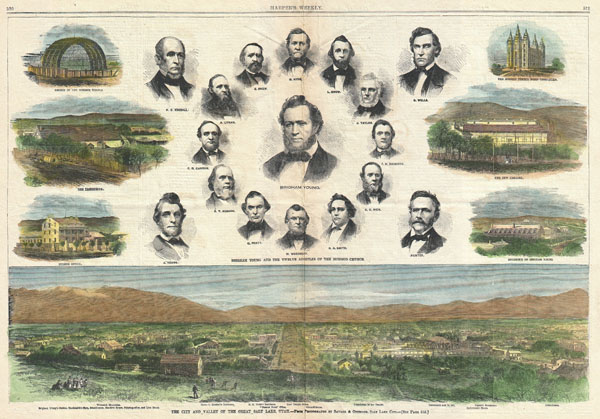Digital Image: 1866 Harper's Weekly View of Salt Lake City, Utah w- Brigham Young (Mormons)
SaltLakeCity-harpersweekly-1866_d
Title
1866 (dated) 14 x 21 in (35.56 x 53.34 cm)
Description
FOR THE ORIGINAL ANTIQUE MAP, WITH HISTORICAL ANALYSIS, CLICK HERE.
Digital Map Information
Geographicus maintains an archive of high-resolution rare map scans. We scan our maps at 300 DPI or higher, with newer images being 600 DPI, (either TIFF or JPEG, depending on when the scan was done) which is most cases in suitable for enlargement and printing.
Delivery
Once you purchase our digital scan service, you will receive a download link via email - usually within seconds. Digital orders are delivered as ZIP files, an industry standard file compression protocol that any computer should be able to unpack. Some of our files are very large, and can take some time to download. Most files are saved into your computer's 'Downloads' folder. All delivery is electronic. No physical product is shipped.
Credit and Scope of Use
You can use your digial image any way you want! Our digital images are unrestricted by copyright and can be used, modified, and published freely. The textual description that accompanies the original antique map is not included in the sale of digital images and remains protected by copyright. That said, we put significant care and effort into scanning and editing these maps, and we’d appreciate a credit when possible. Should you wish to credit us, please use the following credit line:
Courtesy of Geographicus Rare Antique Maps (https://www.geographicus.com).
How Large Can I Print?
In general, at 300 DPI, you should at least be able to double the size of the actual image, more so with our 600 DPI images. So, if the original was 10 x 12 inches, you can print at 20 x 24 inches, without quality loss. If your display requirements can accommodate some loss in image quality, you can make it even larger. That being said, no quality of scan will allow you to blow up at 10 x 12 inch map to wall size without significant quality loss. For more information, it is best consult a printer or reprographics specialist.
Refunds
If the high resolution image you ordered is unavailable, we will fully refund your purchase. Otherwise, digital images scans are a service, not a tangible product, and cannot be returned or refunded once the download link is used.
Cartographer S
Harper and Brothers (1817 – Present) is New York based American printing publishing firm founded in 1817 by James Harper and his brother John Harper as J. and J. Harper (1817-1833). Their younger brothers Joseph Wesley Harper and Fletcher Harper joined the company around 1926 prompting the 1833 imprint change to Harper and Brothers (1833 – 1962). The firm published countless books, magazines, prints, maps, and more. They began publishing a monthly magazine, Harper's Monthly in 1850. The success of Harper's Monthly led to the introduction of a popular weekly illustrated journal, Harper's Weekly published from 1857 - 1916. They later introduced Harper's Bazar (1867) and Harper's Young People (1879). From about 1899 the business went through a series of permutations selling off some assets and developing others. The company merged with Row, Peters and Company inn 1962, rebranding itself as Harper and Row (1962 – 1990), which was acquired by Marshall Pickering in 1988. It was acquired by Rupert Mordoch (News Corp) and merged with William Collins and Sons in 1990 to form HaprerCollins (1990 – Present), the imprint under which it still publishes. Their original offices were at 331 Franklin Street, roughly below today's Manhattan Bridge. Today they have many offices and are one of the world's largest publishing companies and one of the 'Big Five' English-language publishers. More by this mapmaker...
Charles Roscoe Savage (August 16, 1832 - 1909) was an important English ambrotypist and photographer best known for his work in the American West. Savage had a difficult childhood and suffered in extreme poverty working numerous menial jobs in his home city of Southampton, England. Around 1848 Savage attended a lecture on Mormonism and, inspired, converted to the faith. His devotion to the ideals of Mormonism led him to be disowned by his family. Nonetheless, through his Mormon connections, Savage found his way to New York where he worked in a printing office. He was inspired to photography by the work of Thomas B. H. Stenhouse. In 1859 Savage joined Captain Brown's caravan to Salt Lake City, where he settled and set up a photography studio with Marsena Cannon. There he also met and began working with painter Charles Ottinger who tinted Savage's photographs. Savage was inspired by the people and places of the American West and it is these photos, discovered by New York Publisher Sameul R. Wells, that made his name. Wells who sold the Savage & Ottinger photographs to newspapers and magazines such as Harper's Weekly and the London Illustrated News. Savage & Ottinger ended their short and tumultuous business partnership in 1864, though it is during this time that Savage produced much of his most important work. Savage was awarded prizes for his photographs in several World Fairs including Chicago, St. Louis and San Francisco. Sadly much of Savages photographic work was destroyed when a fire struck his studio in 1883. Savage died in Salt Lake City on February 3, 1909. Learn More...

